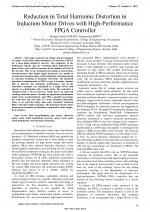| 1/2022 - 5 |
Reduction in Total Harmonic Distortion in Induction Motor Drives with High-Performance FPGA ControllerSUMAM, M. J. |
| Extra paper information in |
| Click to see author's profile in |
| Download PDF |
Author keywords
field programmable gate arrays, induction motor, pulse width modulation inverters, space vector pulse width modulation, total harmonic distortion
References keywords
electronics(22), industrial(15), power(14), applications(12), multilevel(11), voltage(8), space(8), control(8), inverters(7), converters(7)
Blue keywords are present in both the references section and the paper title.
About this article
Date of Publication: 2022-02-28
Volume 22, Issue 1, Year 2022, On page(s): 39 - 46
ISSN: 1582-7445, e-ISSN: 1844-7600
Digital Object Identifier: 10.4316/AECE.2022.01005
Web of Science Accession Number: 000762769600005
SCOPUS ID: 85126823628
Abstract
This paper proposes the design and development of a space vector pulse width modulated v/f controller in FPGA for a three-phase multilevel inverter. The complexity of the modulation scheme and the switching signal generation for motor drives rises with the increase in the number of levels of the inverter. Due to the sequential processing of instructions, microprocessors and digital signal processors are unable to execute short duration pulse width modulated switching signals in real-time, resulting in harmonic distortion. The proposed algorithm is implemented in FPGA to get a dynamic response and to improve the harmonic performance. All of the controller's modules are embedded in a single FPGA and operate in synchronism with a single clock. The controller is validated with a 4-Level inverter, which drives an open-end winding induction motor. Because of algorithm optimization, single clock synchronization, and FPGA parallel processing, the controller has less than 1% total harmonic distortion. There is no need for bulky and costly harmonic reduction filters with this design technique. The proposed scheme shows much better harmonic performance compared to other higher-level schemes. |
| References | | | Cited By |
Web of Science® Times Cited: 0
View record in Web of Science® [View]
View Related Records® [View]
Updated today
SCOPUS® Times Cited: 0
View record in SCOPUS® [Free preview]
There are no citing papers in the CrossRef Cited-by Linking system.
Disclaimer: All information displayed above was retrieved by using remote connections to respective databases. For the best user experience, we update all data by using background processes, and use caches in order to reduce the load on the servers we retrieve the information from. As we have no control on the availability of the database servers and sometimes the Internet connectivity may be affected, we do not guarantee the information is correct or complete. For the most accurate data, please always consult the database sites directly. Some external links require authentication or an institutional subscription.
Web of Science® is a registered trademark of Clarivate Analytics, Scopus® is a registered trademark of Elsevier B.V., other product names, company names, brand names, trademarks and logos are the property of their respective owners.
Faculty of Electrical Engineering and Computer Science
Stefan cel Mare University of Suceava, Romania
All rights reserved: Advances in Electrical and Computer Engineering is a registered trademark of the Stefan cel Mare University of Suceava. No part of this publication may be reproduced, stored in a retrieval system, photocopied, recorded or archived, without the written permission from the Editor. When authors submit their papers for publication, they agree that the copyright for their article be transferred to the Faculty of Electrical Engineering and Computer Science, Stefan cel Mare University of Suceava, Romania, if and only if the articles are accepted for publication. The copyright covers the exclusive rights to reproduce and distribute the article, including reprints and translations.
Permission for other use: The copyright owner's consent does not extend to copying for general distribution, for promotion, for creating new works, or for resale. Specific written permission must be obtained from the Editor for such copying. Direct linking to files hosted on this website is strictly prohibited.
Disclaimer: Whilst every effort is made by the publishers and editorial board to see that no inaccurate or misleading data, opinions or statements appear in this journal, they wish to make it clear that all information and opinions formulated in the articles, as well as linguistic accuracy, are the sole responsibility of the author.



